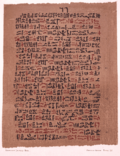Ebers Papyrus
Ebers Papyrus is one of the most significant and extensively preserved medical papyri of Ancient Egypt. Named after Georg Ebers, a German Egyptologist who procured it in the late 19th century, the Ebers Papyrus is dated circa 1550 BC and is one of the oldest known medical texts.
Overview[edit]
The Ebers Papyrus is a 110-page scroll, which is about 20 meters long. It contains 700 magical formulas and remedies, revealing much about the medical knowledge the ancient Egyptians possessed, their understanding of diseases, and their approach to health care. It covers a broad range of topics, including gynecology, dermatology, digestive diseases, head diseases, surgery and traumatology, among others.
Content[edit]
The Ebers Papyrus is written in hieratic Egyptian writing, translated into English and other languages. It begins with a table of contents, followed by a list of ailments along with their associated treatments. The conditions are organized by the part of the body they affect. The papyrus also includes a section on magic and spells, which were considered part of the medical practice in ancient Egypt.
Significance[edit]
The Ebers Papyrus not only provides insights into the medical practices of ancient Egypt but also sheds light on their society and beliefs. It reveals that the Egyptians had a relatively advanced understanding of medicine, including knowledge of the circulatory system, the use of birth control, and treatments for diseases such as diabetes and depression.
See also[edit]
Ad. Transform your life with W8MD's Budget GLP-1 injections from $75


W8MD offers a medical weight loss program to lose weight in Philadelphia. Our physician-supervised medical weight loss provides:
- Weight loss injections in NYC (generic and brand names):
- Zepbound / Mounjaro, Wegovy / Ozempic, Saxenda
- Most insurances accepted or discounted self-pay rates. We will obtain insurance prior authorizations if needed.
- Generic GLP1 weight loss injections from $75 for the starting dose.
- Also offer prescription weight loss medications including Phentermine, Qsymia, Diethylpropion, Contrave etc.
NYC weight loss doctor appointmentsNYC weight loss doctor appointments
Start your NYC weight loss journey today at our NYC medical weight loss and Philadelphia medical weight loss clinics.
- Call 718-946-5500 to lose weight in NYC or for medical weight loss in Philadelphia 215-676-2334.
- Tags:NYC medical weight loss, Philadelphia lose weight Zepbound NYC, Budget GLP1 weight loss injections, Wegovy Philadelphia, Wegovy NYC, Philadelphia medical weight loss, Brookly weight loss and Wegovy NYC
|
WikiMD's Wellness Encyclopedia |
| Let Food Be Thy Medicine Medicine Thy Food - Hippocrates |
Medical Disclaimer: WikiMD is not a substitute for professional medical advice. The information on WikiMD is provided as an information resource only, may be incorrect, outdated or misleading, and is not to be used or relied on for any diagnostic or treatment purposes. Please consult your health care provider before making any healthcare decisions or for guidance about a specific medical condition. WikiMD expressly disclaims responsibility, and shall have no liability, for any damages, loss, injury, or liability whatsoever suffered as a result of your reliance on the information contained in this site. By visiting this site you agree to the foregoing terms and conditions, which may from time to time be changed or supplemented by WikiMD. If you do not agree to the foregoing terms and conditions, you should not enter or use this site. See full disclaimer.
Credits:Most images are courtesy of Wikimedia commons, and templates, categories Wikipedia, licensed under CC BY SA or similar.
Translate this page: - East Asian
中文,
日本,
한국어,
South Asian
हिन्दी,
தமிழ்,
తెలుగు,
Urdu,
ಕನ್ನಡ,
Southeast Asian
Indonesian,
Vietnamese,
Thai,
မြန်မာဘာသာ,
বাংলা
European
español,
Deutsch,
français,
Greek,
português do Brasil,
polski,
română,
русский,
Nederlands,
norsk,
svenska,
suomi,
Italian
Middle Eastern & African
عربى,
Turkish,
Persian,
Hebrew,
Afrikaans,
isiZulu,
Kiswahili,
Other
Bulgarian,
Hungarian,
Czech,
Swedish,
മലയാളം,
मराठी,
ਪੰਜਾਬੀ,
ગુજરાતી,
Portuguese,
Ukrainian



